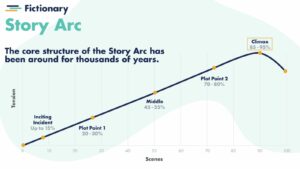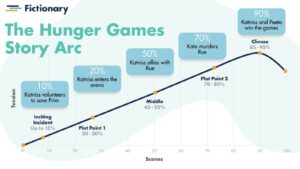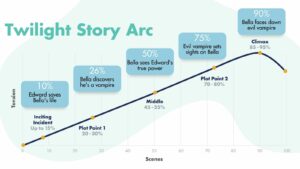
Ah, the plot diagram! Think of it as the GPS of storytelling. A road map for your story’s journey. It’s not just a squiggly line on a page; the plot diagram guides your narrative from “Once upon a time” to “And they lived happily ever after” (or not, depending on your genre).
What Is a Plot Diagram?
At its heart, a plot diagram is a simple (yet ingenious) tool that authors use to structure their stories. But don’t be fooled by its apparent simplicity. This little diagram is powerful enough to transform a jumble of ideas into a cohesive and compelling narrative.
Plot Diagram Example

Okay, the above heading says the Fictionary Story Arc is an example of a plot diagram… and it is. But it’s so much more than that! The Fictionary Story Arc is like the plot diagram’s cooler, tech-savvy cousin.
But why all these terms? What’s the difference? The story arc is the path your story travels. The plot diagram, on the other hand, is the graphic depiction of that path. If the story arc is the scenic route your story takes, the plot diagram is the ‘You Are Here’ mall map, showing you all the key stops along the way. So when we talk about the plot diagram, we’re talking about the actual visual representation of your story arc.
We show the story arc through a plot diagram. The plot diagram is the graph of your story arc.
Fictionary tracks thirty-eight story elements. It’s a lot! But each of these are grouped into three overarching categories, or supergroups: character, setting, and …. Wait for it…. PLOT.
Plot comprises the story itself, and anything having to do with its progression. The plot diagram typically follows a classic three-act structure. It’s basically the beginning, middle, and end of your story. However, within these three acts, there are key components. The Fictionary Story Arc is based on that classic three-act structure. Within these three acts, you have five plot points.
And that is where Fictionary can help. It doesn’t just help you create your story arc. It doesn’t just help you ensure that your plot points are at the right place for the standard three-act structure. Oh, no. It does not stop there.
The Fictionary StoryTeller software actually creates a plot diagram of your story arc. You upload your manuscript, and Fictionary uses magic (I mean, algorithms) to map your story arc. Then you, the human, go in and check to see if it got things right. If not, you can manually adjust those plot points as needed.
So what are these mysterious five plot points of which we speak?
Inciting Incident
Before the inciting incident, the story should draw the reader in. Here, you’ll want to cozy up with your characters, peek into their everyday lives, and get a glimpse of their big dreams and the hurdles they might face. This helps the reader connect with the protagonist. To care about what happens to them.
And then—BAM! The inciting incident knocks the protagonist out of their ordinary life. Their world changes in a dramatic way.
This is the “Hold my coffee” moment of your story. It’s the spark that lights the fire, the event that kicks your protagonist off their couch and into the adventure. Whether it’s finding a mysterious map or getting an unexpected invitation, this is where your story says, “Buckle up, we’re going on a journey!”
The inciting incident can be positive or negative, but it must be. Without one, life for your protagonist just goes on as usual—not so interesting, from a story perspective.
The Rising Action Chart
The rising action is the death of Act 1, and there is no other option for the protagonist but to go into Act 2. It’s the moment when your protagonist’s world shifts from ‘maybe’ to ‘must.’ It’s where the story’s rubber burns hot on the road of adventure.
By Plot Point 1, which is about 25% into your novel, your story starts to sizzle with conflict and tension. Your characters are up against challenges, making choices that will shape their journey. By this point, the story has shown what’s at stake for the protagonist, and given them no choice but to go forward anyway. The greater the stakes, the greater the tension.
Middle
Welcome to the heart of your story, where the plot thickens like a delicious stew. Here, characters evolve, secrets unfold, and the stakes get higher. It’s the meat in the sandwich, the core of your narrative apple. This part keeps your readers glued to the pages, hungry for more.
As your protagonist ventures deeper into this heartland, they encounter this pivotal Middle Plot Point. This is where they learn the unwritten rules of their journey. Armed with this new understanding, the protagonist shifts from being a mere pawn of fate to the bold chess master of their destiny. In other words, the middle marks the turning point in which the protagonist shifts from reactive to proactive.
Plot Point 2
Plot Point 2 is the end of Act 2, and happens at about 75% into your novel.
Often referred to as the “all hope is lost” scene, or the Dark Night of the Soul, Plot Point 2 is the “Oh no, what now?” moment. Imagine your characters, chests puffed with confidence, marching towards what they think is the finish line—only to find it’s a mirage. This plot point is the narrative rug pull, the moment where the floor gives way, and your protagonist plummets into uncertainty. Just when your characters think they’ve got it all figured out, this plot point begs to differ.
Your protagonist hits rock bottom, their dreams shattered like a glass castle under a sledgehammer. This is the low point, where the light at the end of the tunnel flickers and fades, leaving your characters (and readers) in a gripping suspense.
This plot point is crucial because it’s not just about tearing down your protagonist’s world. It also sets the stage for the triumphant rise in the climax. It’s the darkness before the dawn, the deep breath before the final leap. And in this moment of despair, the seeds of resolution and growth are sown, preparing both character and reader for the story’s grand finale.
Story Climax Chart
The grand finale, the showstopper! All roads lead to this peak of excitement and emotion. The climax is where conflicts reach a boiling point, and your characters face their biggest challenge yet. Like the final showdown in an epic movie, it’s the part your readers have been waiting for with bated breath.
The climax is where your protagonist either achieves—or fails to achieve, depending on your genre—the story goal. So, if your protagonist has been on a journey to find their long lost sister, the climax is where that reunion happens. If the goal is to save the world from alien invasion, then that final battle happens in the climax.
This should be the scene with the most tension, the most conflict, the greatest emotional upheaval. It typically happens at about 90% into your story arc. Everything after that is falling action.
Falling Action
After the climax’s fireworks, the story begins to settle down. It’s the narrative exhale, where conflicts start resolving, and loose ends get tied up. It’s the gentle coast back to the dock after a thrilling boat ride—satisfying, necessary, and a chance for your characters (and readers) to catch their breath.
And it might just set your book up for a sequel.
A Plot Diagram Template

Now, this is where the rubber meets the road. The Fictionary Story Arc isn’t just a static image; it’s a dynamic, interactive tool that breathes life into your plot diagram. The beauty of this template lies in its interactivity. With Fictionary’s StoryTeller software, the Story Arc becomes a hands-on guide for your narrative journey.
Imagine being able to click on a plot point and be instantly transported to the corresponding scene in your manuscript. That’s the kind of wizardry we’re talking about here. The Story Arc with its two lines—one for the standard structure, another mirroring your story—not only shows you where you are but also where you need to go.
This interactive Story Arc is akin to a narrative EKG, tracing the heartbeat of your story. If the lines of your plot and the core structure are in sync, you’re in great narrative shape. If they diverge, you’ve got some editing to do. But fear not! This plot diagram template is designed to help you identify and remedy any structural arrhythmias before they become critical.
Examples of Plot Line Diagrams from Literature
The Hunger Games Plot Diagram / Story Arc

The Hunger Games serves as a prime example of a well-crafted plot. Just look at this plot diagram! It’s a beautiful sight to behold. By seeing her story mapped out as a plot diagram in a Fictionary Story Arc, we can see clearly how masterfully Suzanne Collins’s story aligns with the classic three-act structure. Each plot point is a stepping stone that escalates the tension and stakes.
In the inciting incident, Katniss volunteers to save Prim, her sister. This act of self-sacrifice, perfectly poised at 10% into the narrative, definitely fits the bill of shaking our protagonist out of her ordinary life.
As we hit Plot Point 1, Katniss enters the arena (20%). By now, we’re fully invested in her survival. This action is our point-of-no-return. There’s no going back now.
The middle thickens with alliances and adversities. At the midpoint (50%), Katniss goes against her rugged individualism and becomes proactive in her story by allying with Rue.
Then comes the gut-wrenching Plot Point 2: Rue’s death (70%). It’s Katniss’s darkest hour. This moment not only heightens the emotional stakes but also cements Katniss’s resolve, pushing the story toward its climax.
The climax unfurls with Katniss and Peeta winning the games (90%). This high-tension moment delivers on the story’s promises. It’s the culmination of strategy, survival, and sacrifice, rewarding the reader’s emotional investment with a satisfying payoff.
Twilight Plot Diagram / Story Arc

The plot diagram of Twilight displays the clever way Stephanie Meyer builds up romance and danger. In the inciting incident, Edward saves Bella’s life (10%). This not only piques our curiosity about Edward but also stealthily draws Bella into a new world.
Plot Point 1 (26%) marks a significant turn in the story as Bella discovers Edward is—gasp—a vampire. It’s the point of no return for Bella, as her world irrevocably changes. This revelation propels her deeper into Edward’s world, effectively ending Act 1 and setting her on a collision course with forces beyond human understanding.
In the middle point (50%), Bella sees Edward’s true power. We’re at the core of the narrative apple. Bella’s love for Edward deepens, even as the true dangers of his world become more evident. She becomes proactive in her pursuit of this dangerous new world.
As we move towards Plot Point 2, the narrative tension escalates. It reaches a crucial turning point when the evil vampire sets sights on Bella (75%). The stakes are raised to life-and-death proportions, and the shadow of threat looms large.
The climax of Twilight is a face-off where Bella confronts the evil vampire (90%). The conflict reaches its peak and the fate of the characters hangs in the balance.
Conclusion: What Is a Plot Structure Diagram?
From the inciting incident to the climax, the plot diagram illuminates the path your characters have chosen to tread. In this article, we have covered the Fictionary Story Arc and how it works as an interactive plot diagram. We’ve shown how a plot diagram can revolutionize the way your story is structured.
Whether you’re planning a dystopian rebellion or a supernatural romance, the plot diagram can serve as your roadmap. It ensures that every twist, every character arc, and every plot point hits where it will have the most impact. By dissecting these two famous examples, we’ve seen how each plot point is a crucial step forward for the protagonist.
Now it’s your turn. Take the wheel of your own story with the confidence that comes from understanding the nuances of the plot diagram. Embrace the Fictionary Story Arc (or any plot diagram you prefer), and make it your own. Let it be the guide that keeps your story on its path.
Take your free trial of Fictionary StoryTeller today.


